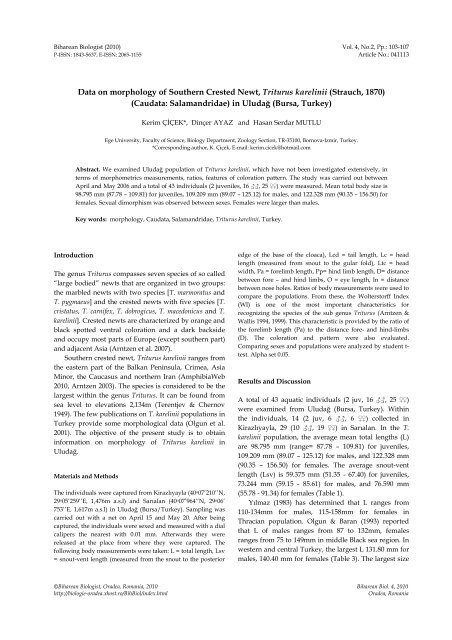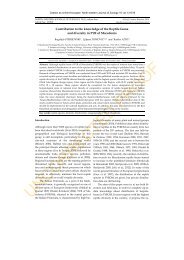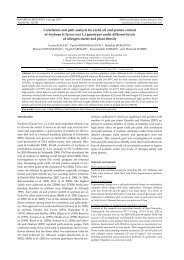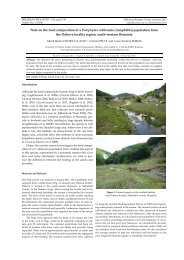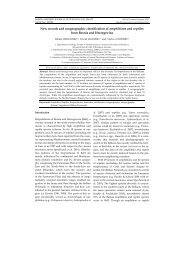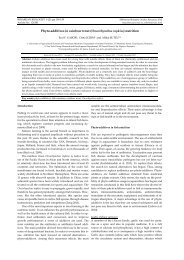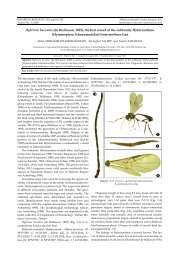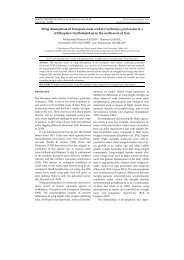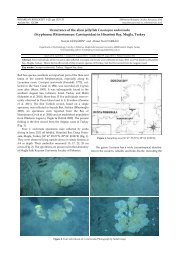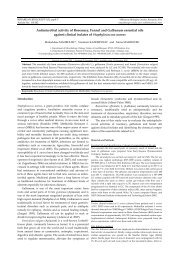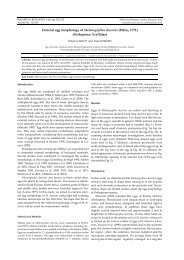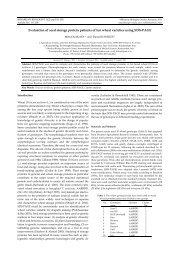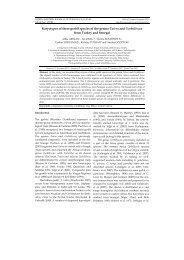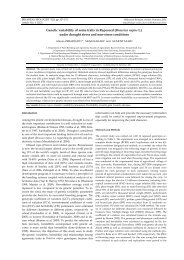Data on morphology of Southern Crested Newt, Triturus karelinii ...
Data on morphology of Southern Crested Newt, Triturus karelinii ...
Data on morphology of Southern Crested Newt, Triturus karelinii ...
Create successful ePaper yourself
Turn your PDF publications into a flip-book with our unique Google optimized e-Paper software.
Biharean Biologist (2010) Vol. 4, No.2, Pp.: 103-107<br />
P-ISSN: 1843-5637, E-ISSN: 2065-1155 Article No.: 041113<br />
Introducti<strong>on</strong><br />
<str<strong>on</strong>g>Data</str<strong>on</strong>g> <strong>on</strong> <strong>morphology</strong> <strong>of</strong> <strong>Southern</strong> <strong>Crested</strong> <strong>Newt</strong>, <strong>Triturus</strong> <strong>karelinii</strong> (Strauch, 1870)<br />
(Caudata: Salamandridae) in Uludağ (Bursa, Turkey)<br />
Kerim ÇİÇEK*, Dinçer AYAZ and Hasan Serdar MUTLU<br />
Ege University, Faculty <strong>of</strong> Science, Biology Department, Zoology Secti<strong>on</strong>, TR-35100, Bornova-Izmir, Turkey.<br />
*Corresp<strong>on</strong>ding author, K. Çiçek, E-mail: kerim.cicek@hotmail.com<br />
Abstract. We examined Uludağ populati<strong>on</strong> <strong>of</strong> <strong>Triturus</strong> <strong>karelinii</strong>, which have not been investigated extensively, in<br />
terms <strong>of</strong> morphometrics measurements, ratios, features <strong>of</strong> colorati<strong>on</strong> pattern. The study was carried out between<br />
April and May 2006 and a total <strong>of</strong> 43 individuals (2 juveniles, 16 ♂♂, 25 ♀♀) were measured. Mean total body size is<br />
98.795 mm (87.78 – 109.81) for juveniles, 109.209 mm (89.07 – 125.12) for males, and 122.328 mm (90.35 – 156.50) for<br />
females. Sexual dimorphism was observed between sexes. Females were larger than males.<br />
Key words: <strong>morphology</strong>, Caudata, Salamandridae, <strong>Triturus</strong> <strong>karelinii</strong>, Turkey.<br />
The genus <strong>Triturus</strong> compasses seven species <strong>of</strong> so called<br />
“large bodied” newts that are organized in two groups:<br />
the marbled newts with two species [T. marmoratus and<br />
T. pygmaeus] and the crested newts with five species [T.<br />
cristatus, T. carnifex, T. dobrogicus, T. maced<strong>on</strong>icus and T.<br />
<strong>karelinii</strong>]. <strong>Crested</strong> newts are characterized by orange and<br />
black spotted ventral colorati<strong>on</strong> and a dark backside<br />
and occupy most parts <strong>of</strong> Europe (except southern part)<br />
and adjacent Asia (Arntzen et al. 2007).<br />
<strong>Southern</strong> crested newt, <strong>Triturus</strong> <strong>karelinii</strong> ranges from<br />
the eastern part <strong>of</strong> the Balkan Peninsula, Crimea, Asia<br />
Minor, the Caucasus and northern Iran (AmphibiaWeb<br />
2010, Arntzen 2003). The species is c<strong>on</strong>sidered to be the<br />
largest within the genus <strong>Triturus</strong>. It can be found from<br />
sea level to elevati<strong>on</strong>s 2,134m (Terentjev & Chernov<br />
1949). The few publicati<strong>on</strong>s <strong>on</strong> T. <strong>karelinii</strong> populati<strong>on</strong>s in<br />
Turkey provide some morphological data (Olgun et al.<br />
2001). The objective <strong>of</strong> the present study is to obtain<br />
informati<strong>on</strong> <strong>on</strong> <strong>morphology</strong> <strong>of</strong> <strong>Triturus</strong> <strong>karelinii</strong> in<br />
Uludağ.<br />
Materials and Methods<br />
The individuals were captured from Kirazlıyayla (40 o07’210’’N,<br />
29 o05’259’’E, 1,476m a.s.l) and Sarıalan (40 o07’964’’N, 29 o06’<br />
753’’E, 1,617m a.s.l) in Uludağ (Bursa/Turkey). Sampling was<br />
carried out with a net <strong>on</strong> April 15 and May 20. After being<br />
captured, the individuals were sexed and measured with a dial<br />
calipers the nearest with 0.01 mm. Afterwards they were<br />
released at the place from where they were captured. The<br />
following body measurements were taken: L = total length, Lsv<br />
= snout-vent length (measured from the snout to the posterior<br />
edge <strong>of</strong> the base <strong>of</strong> the cloaca), Lcd = tail length, Lc = head<br />
length (measured from snout to the gular fold), Ltc = head<br />
width, Pa = forelimb length, Pp= hind limb length, D= distance<br />
between fore – and hind limbs, O = eye length, In = distance<br />
between nose holes. Ratios <strong>of</strong> body measurements were used to<br />
compare the populati<strong>on</strong>s. From these, the Wolterstorff Index<br />
(WI) is <strong>on</strong>e <strong>of</strong> the most important characteristics for<br />
recognizing the species <strong>of</strong> the sub genus <strong>Triturus</strong> (Arntzen &<br />
Wallis 1994, 1999). This characteristic is provided by the ratio <strong>of</strong><br />
the forelimb length (Pa) to the distance fore- and hind-limbs<br />
(D). The colorati<strong>on</strong> and pattern were also evaluated.<br />
Comparing sexes and populati<strong>on</strong>s were analyzed by student ttest.<br />
Alpha set 0.05.<br />
Results and Discussi<strong>on</strong><br />
A total <strong>of</strong> 43 aquatic individuals (2 juv, 16 ♂♂, 25 ♀♀)<br />
were examined from Uludağ (Bursa, Turkey). Within<br />
the individuals, 14 (2 juv, 6 ♂♂, 6 ♀♀) collected in<br />
Kirazlıyayla, 29 (10 ♂♂, 19 ♀♀) in Sarıalan. In the T.<br />
<strong>karelinii</strong> populati<strong>on</strong>, the average mean total lengths (L)<br />
are 98.795 mm (range= 87.78 – 109.81) for juveniles,<br />
109.209 mm (89.07 – 125.12) for males, and 122.328 mm<br />
(90.35 – 156.50) for females. The average snout-vent<br />
length (Lsv) is 59.375 mm (51.35 - 67.40) for juveniles,<br />
73.244 mm (59.15 - 85.61) for males, and 76.590 mm<br />
(55.78 - 91.34) for females (Table 1).<br />
Yılmaz (1983) has determined that L ranges from<br />
110-134mm for males, 115-158mm for females in<br />
Thracian populati<strong>on</strong>. Olgun & Baran (1993) reported<br />
that L <strong>of</strong> males ranges from 87 to 132mm, females<br />
ranges from 75 to 149mm in middle Black sea regi<strong>on</strong>. In<br />
western and central Turkey, the largest L 131.80 mm for<br />
males, 140.40 mm for females (Table 3). The largest size<br />
©Biharean Biologist, Oradea, Romania, 2010 Biharean Biol. 4, 2010<br />
http://biologie-oradea.xhost.ro/BihBiol/index.html Oradea, Romania
104<br />
(L) reported at <strong>Triturus</strong> <strong>karelinii</strong> is 145 mm for males and<br />
160 mm for females (Buresch & Z<strong>on</strong>kov 1941). In the<br />
Biharean Biol. 4, 2010<br />
Çiçek, K. et al.<br />
Uludağ populati<strong>on</strong>, the largest male was 125.12 mm and<br />
the female measured 156.60mm.<br />
Table 1. Body measurements (in mm) and ratios <strong>of</strong> <strong>Triturus</strong> <strong>karelinii</strong>. [n= number <strong>of</strong> specimens, x= mean, SE= standard error <strong>of</strong><br />
mean, Min.-Max.= extreme values, SD= standard deviati<strong>on</strong>]<br />
Characters<br />
juveniles ♂♂ ♀♀<br />
n x SE Min. - Max. SD n x SE Min. - Max. SD n x SE Min. - Max. SD<br />
L 2 98.795 11.015 87.78 - 109.81 15.578 14 109.209 2.194 89.07 - 125.12 8.208 21 122.328 3.659 90.35 - 156.60 16.769<br />
Lsv 2 59.375 8.025 51.35 - 67.40 11.349 104* 73.244 0.531 59.15 – 85.61 5.415 113* 76.590 0.702 55.78 – 91.34 7.466<br />
Lcd 2 39.420 2.990 36.4 - 42.4 4.228 14 42.756 1.780 27.8 - 57.1 6.661 21 52.632 2.300 27.7 - 71.6 10.539<br />
Lc 2 14.570 1.940 12.63 - 16.51 2.744 16 15.226 0.276 13.51 - 17.30 1.102 25 16.718 0.257 12.56 - 19.11 1.285<br />
Ltc 2 11.645 1.285 10.36 - 12.93 1.817 16 12.624 0.247 10.73 - 14.49 0.990 25 13.711 0.227 11.42 - 15.92 1.137<br />
Pa 2 21.660 3.710 17.95 - 25.37 5.247 16 22.859 0.551 19.43 - 26.20 2.202 25 22.618 0.480 17.18 - 25.77 2.401<br />
Pp 2 22.385 4.015 18.37 - 26.40 5.678 16 24.034 0.600 19.80 - 28.79 2.399 25 22.714 0.514 17.53 - 27.50 2.572<br />
D 2 28.560 3.960 24.60 - 32.52 5.600 16 31.759 0.636 26.60 - 35.46 2.543 25 35.002 0.964 26.80 - 46.76 4.820<br />
O 2 3.670 0.080 3.59 - 3.75 0.113 16 3.685 0.143 2.50 - 4.65 0.574 25 3.797 0.084 2.97 - 4.55 0.419<br />
In 2 2.580 0.090 2.49 - 2.67 0.127 16 2.465 0.129 1.81 - 3.67 0.517 25 2.655 0.093 1.37 - 3.53 0.464<br />
Lc-L 2 0.147 0.003 0.14 - 0.15 0.005 14 0.142 0.003 0.13 - 0.17 0.012 21 0.138 0.003 0.11 - 0.17 0.014<br />
Ltc-L 2 0.118 0.000 0.12 - 0.12 0.000 14 0.118 0.002 0.11 - 0.14 0.007 21 0.114 0.002 0.09 - 0.14 0.011<br />
Lcd-L 2 0.401 0.014 0.39 - 0.42 0.020 14 0.390 0.010 0.31 - 0.46 0.038 21 0.427 0.009 0.31 - 0.48 0.041<br />
Lc-Ltc 2 1.248 0.029 1.22 - 1.28 0.041 16 1.208 0.015 1.12 - 1.33 0.058 25 1.221 0.013 1.10 - 1.39 0.067<br />
Pa-D 2 0.755 0.025 0.73 - 0.78 0.036 16 0.724 0.021 0.55 - 0.86 0.085 25 0.655 0.019 0.49 - 0.94 0.097<br />
Pp-D 2 0.779 0.033 0.75 - 0.81 0.046 16 0.760 0.021 0.62 - 0.91 0.085 25 0.656 0.018 0.56 - 1.00 0.092<br />
Lsv-L 2 0.599 0.014 0.58 - 0.61 0.020 14 0.610 0.010 0.54 - 0.69 0.038 21 0.573 0.009 0.52 - 0.69 0.041<br />
Lsv-Lcd 2 1.499 0.090 1.41 -1.59 0.127 14 1.591 0.073 1.19 - 2.21 0.272 21 1.368 0.062 1.10 - 2.26 0.282<br />
In-Ltc 2 0.223 0.017 0.21 - 0.24 0.024 16 0.195 0.010 0.16 - 0.31 0.038 25 0.193 0.005 0.12 - 0.23 0.026<br />
O-Ltc 2 0.318 0.028 0.29 - 0.35 0.040 16 0.291 0.009 0.22 - 0.35 0.034 25 0.277 0.005 0.23 - 0.33 0.024<br />
Ltc-Lsv 2 0.197 0.005 0.19 - 0.20 0.007 16 0.192 0.002 0.18 - 0.21 0.009 25 0.199 0.003 0.16 - 0.24 0.015<br />
*Additi<strong>on</strong>al Lsv data obtained from Mermer et al. 2008.<br />
Table 2. t test results between sexes [t= t table value,<br />
df= degrees <strong>of</strong> freedom, P= significant level]<br />
Characters t df P<br />
L 2.604 33 0.014<br />
Lsv 1.668 39 0.103<br />
Lcd 2.825 33 0.008<br />
Lc 3.705 39 0.001<br />
Ltc 3.136 39 0.003<br />
Pa 0.352 39 0.727<br />
Pp 1.629 39 0.111<br />
D 2.413 39 0.021<br />
O 0.845 39 0.403<br />
In 1.218 39 0.231<br />
Lc-L 0.847 33 0.403<br />
Ltc-L 1.232 33 0.227<br />
Lcd-L 2.643 33 0.012<br />
Lc-Ltc 0.636 39 0.528<br />
Pa-D 2.390 39 0.022<br />
Pp-D 3.794 39 0.001<br />
Lsv-L 2.740 33 0.010<br />
Lsv-Lcd 2.740 33 0.010<br />
In-Ltc 0.193 39 0.848<br />
The Lsv in the Caucasian populati<strong>on</strong> (Georgia) <strong>of</strong> T.<br />
<strong>karelinii</strong> varies between 65-72 mm for males and 64-80<br />
mm for females (Tarkhnishvili & Gokhelashvili 1999).<br />
Olgun et al. (2005) reported mean Lsv 72.0 mm (60-82)<br />
for males, 73.7mm (55-90) for females and did not differ<br />
significantly between sexes. The average Lsv <strong>of</strong> males<br />
was 63.50 mm (55.44–77.4) and 68.98 mm (56.78–83.18)<br />
in the case <strong>of</strong> the females in Adapazarı (Northwestern<br />
Turkey) (Üzüm & Olgun 2009).<br />
The ground colour <strong>of</strong> the dorsum and flanks <strong>of</strong> our<br />
specimens are dark brown, almost black (Fig. 1a). In this<br />
ground, spots are more or less obvious. The dorsal crest<br />
is dark, with irregularly dispersed spots. Belly and<br />
throat bright orange, solidly covered with black spots <strong>of</strong><br />
irregular shape (Fig. 1b). Spots <strong>on</strong> the throat are smaller<br />
than those <strong>on</strong> the belly. At some individuals the spots<br />
were merged. Generally the colorati<strong>on</strong> <strong>of</strong> females is<br />
similar. The colorati<strong>on</strong> <strong>of</strong> Uludağ populati<strong>on</strong> is in<br />
accordance with the literature (Başoğlu & Özeti 1973,<br />
Yılmaz, 1983, Olgun & Baran 1993, Tarkhnishvili &<br />
Gokhelashvili 1999, Olgun et al. 2001, Arntzen 2003).<br />
With respect to L, Lcd, Lc, Ltc, D, Lcd-L, Pa-D, Pp-D,<br />
Lsv-L and Lsv-Lcd values, statistically significant<br />
differences were found between the sexes. The females<br />
were significantly larger than the males (Table 2). There
Morphology <strong>of</strong> <strong>Southern</strong> <strong>Crested</strong> <strong>Newt</strong>, <strong>Triturus</strong> <strong>karelinii</strong> in Uludağ (Bursa, Turkey)<br />
Locality<br />
Tokat-Center*<br />
Tokat-Reşadiye*<br />
Tokat-Şerefiye*<br />
Tokat-Gökçekent*<br />
İzmir-Bozdağ**<br />
Sivas-Koyulhisar**<br />
İstanbul**<br />
Bursa-Uludağ<br />
* Olgun and Baran (1993), ** Olgun et al. (2001)<br />
Table 3. Comparis<strong>on</strong> <strong>of</strong> some measurements (in mm) and ratios <strong>of</strong> <strong>Triturus</strong> <strong>karelinii</strong> in Turkey.<br />
L Lsv Lcd Pa-D Pp-D<br />
♂♂ ♀♀ ♂♂ ♀♀ ♂♂ ♀♀ ♂♂ ♀♀ ♂♂ ♀♀<br />
x 111.74 130.80<br />
SD 8.68 11.13<br />
x 101.09 115.45<br />
SD 6.84 11.07<br />
x 115.39 126.21<br />
SD 7.27 9.35<br />
x 121.97 133.72<br />
SD 6.80 8.87<br />
x 131.80 137.90 75.70 75.80 56.00 62.00 0.64 0.57 0.66 0.59<br />
SD 6.85 10.24 5.55 3.66 3.02 6.70 0.03 0.03 0.03 0.03<br />
x 122.80 140.40 70.60 76.20 52.30 64.30 0.72 0.64 0.77 0.68<br />
SD 6.62 7.35 4.17 3.91 2.76 3.83 0.04 0.03 0.05 0.02<br />
x 123.00 133.20 70.70 72.60 52.30 60.60 0.72 0.60 0.75 0.62<br />
SD 5.27 8.99 3.08 4.31 2.84 5.95 0.04 0.03 0.04 0.03<br />
x 109.21 122.33 73.24 76.59 42.76 52.63 0.72 0.65 0.76 0.66<br />
SD 8.21 16.77 5.41 7.47 6.66 10.54 0.08 0.10 0.08 0.09<br />
(a) (b)<br />
Figure 1. The most comm<strong>on</strong> dorsal (a) and ventral (b) pattern <strong>of</strong> <strong>Triturus</strong> <strong>karelinii</strong> in Uludağ<br />
Table 4. The Wolterstorff Index (Pa/D) <strong>of</strong> the various populati<strong>on</strong>s <strong>of</strong> <strong>Triturus</strong> <strong>karelinii</strong><br />
Locality Pa/D ♂ (WI) Pa/D ♀ (WI) Source<br />
Romania 0.69 - 0.82 0.67 - 0.72 Fuhn (1960)<br />
Palaearctic 0.69 - 0.82 0.67 - 0.72 Thorn (1968)<br />
Thrace 0.62 - 0.83 0.57 - 0.77 Yılmaz (1983)<br />
Yugoslavia 0.53 - 0.65 Wallis and Arntzen (1989)<br />
Bulgaria 0.57 - 0.64<br />
Turkey 0.59 - 0.67<br />
Turkey 0.50 - 0.91 0.50 - 0.80 Olgun and Baran (1993)<br />
General 0.57 - 0.67 Arntzen and Wallis (1994)<br />
General 0.55 - 0.70 Griffths (1996)<br />
Bozdağ 0.59 - 0.67 0.52 - 0.60 Olgun et al. (2001)<br />
Koyulhisar 0.66 - 0.79 0.60 - 0.80<br />
İstanbul 0.66 - 0.81 0.56 - 0.64<br />
General ≥0.671 ≥0.592 Arntzen 2003<br />
Uludağ 0.55 - 0.86 0.49 - 0.94 Present Study<br />
105<br />
Biharean Biol. 4, 2010
106<br />
is a sexual dimorphism between the sexes, which is<br />
emphasized by previous studies (Olgun & Baran 1993,<br />
Olgun et al. 2001, Üzüm & Olgun 2009). In terms <strong>of</strong> Lsv,<br />
there were differences (Üzüm & Olgun 2009), some <strong>of</strong><br />
which were not between the sexes (Olgun & Baran 1993,<br />
Olgun et al. 2001, Olgun et al. 2005, Mermer et al. 2008).<br />
Also we did not determine any statistical differences in<br />
terms <strong>of</strong> Lsv. Sexual dimorphism is generally lower in<br />
urodeles (61%) compared to anurans (90%) (Shine 1979).<br />
Ivanović et al (2008) state that key factors in the<br />
evoluti<strong>on</strong> <strong>of</strong> female size seem to be primarily correlated<br />
with str<strong>on</strong>g selective pressures <strong>on</strong> female fecundity, as<br />
the relative size and shape <strong>of</strong> females’ abdomen may be<br />
tightly associated with fecundity (e.g. Shine 1989).<br />
As shown in Table 3, there were some differences in<br />
terms <strong>of</strong> Lcd, Pa-D and Pp-D values am<strong>on</strong>g populati<strong>on</strong>s.<br />
A possible reas<strong>on</strong> for this is derived from the<br />
development <strong>of</strong> individuals. Uludağ populati<strong>on</strong>s have<br />
lower values regarding the aspect <strong>of</strong> L and some <strong>of</strong> the<br />
related ratios [Lsv and Lcd]. Besides, in terms <strong>of</strong> Pa-D<br />
and Pp-D rati<strong>on</strong>, there were similarities am<strong>on</strong>g İstanbul,<br />
Sivas and İzmir (Olgun et al. 2001) (Table 3).<br />
Destructi<strong>on</strong> <strong>of</strong> forests and wetlands, agrochemical<br />
pollutants and other anthropogenic factors are threatening<br />
populati<strong>on</strong>s <strong>of</strong> <strong>Triturus</strong> <strong>karelinii</strong> (AmphibiaWeb<br />
2010, Arntzen et al. 2008). In Uludağ, although there are<br />
suitable biotopes for amphibians, there are many<br />
pressure elements especially arising from anthropogenic<br />
factors (Çiçek 2009). Because <strong>of</strong> a wide distributi<strong>on</strong> area,<br />
<strong>Triturus</strong> <strong>karelinii</strong> does not have any protecting status.<br />
According to our field observati<strong>on</strong>s, for the sustainability<br />
<strong>of</strong> the species’ populati<strong>on</strong>s some protecti<strong>on</strong> measures<br />
should be taken.<br />
Acknowledgements. This study is partly financially supported by<br />
TUBİTAK [Project number: 105T336], EBİLTEM [2007BİL015] and<br />
Research Fund Accountancy <strong>of</strong> Ege University [2006FEN015]. We<br />
are indebted to these establishments for their financial support. We<br />
thank Biologist S.K. ASERIM for helping in the field studies.<br />
References<br />
AmphibiaWeb (2010): Informati<strong>on</strong> <strong>on</strong> amphibian biology and<br />
c<strong>on</strong>servati<strong>on</strong>. [web applicati<strong>on</strong>]. 2009. Berkeley, California:<br />
AmphibiaWeb. Available: http://amphibiaweb.org/.<br />
(Accessed at Jan 18, 2010).<br />
Arntzen, J. W. (2003): <strong>Triturus</strong> cristatus Superspezies – Kammolch<br />
Artenkreis (<strong>Triturus</strong> cristatus (Laurenti, 1768) – Nördlicher<br />
Kammolch, <strong>Triturus</strong> carnifex (Laurenti, 1768) – Italienischer<br />
Kammolch, <strong>Triturus</strong> dobrogicus (Kiritzescu, 1903) – D<strong>on</strong>au-<br />
Kammolch, <strong>Triturus</strong> <strong>karelinii</strong> (Strauch, 1870) – Südlicher<br />
Kammolch). pp: 421-514. In: Grossenbacher, K. & Thiesmeier,<br />
Biharean Biol. 4, 2010<br />
Çiçek, K. et al.<br />
B. (eds.), Handbuch der Reptilien und Amphibien Europas 4<br />
(IIA), Wiebelsheim: AULA Verlag, S. [in German]<br />
Arntzen, J.W., Espregueira-Themudo, G., Wielstra, B. (2007): The<br />
phylogeny <strong>of</strong> crested newts (<strong>Triturus</strong> cristatus superspecies):<br />
nuclear and mitoch<strong>on</strong>drial genetic characters suggest a hard<br />
polytomy, in line with the paleogeography <strong>of</strong> the centre <strong>of</strong><br />
origin. C<strong>on</strong>tributi<strong>on</strong>s to Zoology 76 (4): 261-278.<br />
Arntzen, J.W., Papenfuss, T. Kuzmin, S.L., Tarkhnishvili, D.N.,<br />
Ishchenko, V. Tuniyev, B., Sparreboom, M., Rastegar-Pouyani,<br />
N., Uğurtaş, İ.H. Anders<strong>on</strong>, S., Babik, W., Miaud, C., Isailovic,<br />
J.C. (2008): <strong>Triturus</strong> <strong>karelinii</strong>. In: IUCN 2009. IUCN Red List <strong>of</strong><br />
Threatened Species. Versi<strong>on</strong> 2009.2. .<br />
Downloaded <strong>on</strong> 18 January 2010.<br />
Arntzen, J.W., Wallis, G.P. (1994): The ‘Wolterstorff Index‘ and its<br />
value to the tax<strong>on</strong>omy <strong>of</strong> the <strong>Crested</strong> <strong>Newt</strong> superspecies.<br />
Abhandlungen und Berichte des Museums für Naturkunde<br />
und Vorgeschichte 17: 57-66.<br />
Arntzen, J.W., Wallis, G.P. (1999): Geographic variati<strong>on</strong> and<br />
tax<strong>on</strong>omy <strong>of</strong> crested newts (<strong>Triturus</strong> cristatus superspecies):<br />
morphological and mitoch<strong>on</strong>drial DNA data. C<strong>on</strong>tributi<strong>on</strong>s to<br />
Zoology 68: 181-203.<br />
Başoğlu, M., Özeti, N. (1973): Türkiye Amfibileri. Ege Üniv. Fen<br />
Fak. Kitaplar Serisi No: 50, İzmir. [in Turkish]<br />
Buresh, I., Z<strong>on</strong>kov, J. (1941): Untersuchungen uber die Verbreitung<br />
der Reptilien und Amphibien in Bulgarien und auf der<br />
Balkanhalbinsel. 111. Teil: Schwanzlurche (Amphibia,<br />
Caudata). Mitteilungen K<strong>on</strong>iglichen Naturwissensehaftliehen<br />
Instituten S<strong>of</strong>ia-Bulgarien 14: 171-237. [in Bulgarian].<br />
Çiçek, K. (2009): Uludağ (Bursa)’da yaşayan, Rana macrocnemis<br />
Boulenger, 1885 (Anura: Ranidae)’in populasy<strong>on</strong> dinamiği. Ege<br />
University, Institute <strong>of</strong> Natural and Applied Science, Ph.D.<br />
thesis, 274p. [In Turkish]<br />
Griffths, R.A. (1996): <strong>Newt</strong>s and Salamanders <strong>of</strong> Europe. T & AD<br />
Poyser Ltd., L<strong>on</strong>d<strong>on</strong>.<br />
Ivanović A, Sotiropoulos K, Furtula M, Džukić G, Kalezić ML.<br />
Ivanovic, A., Tomasevic, N., Dzukic, G., Kalezic, M. L. (2008):<br />
Evoluti<strong>on</strong>ary diversificati<strong>on</strong> <strong>of</strong> the limb skelet<strong>on</strong> in crested<br />
newts (<strong>Triturus</strong> cristatus superspecies, Caudata,<br />
Salamandridae). Annales Zoologici Fennici 45: 527–535.<br />
Mermer, A. Ayaz, D. Çiçek, K. 2008: Abundance <strong>of</strong> Syntopic <strong>Newt</strong>s,<br />
<strong>Triturus</strong> <strong>karelinii</strong> (Strauch, 1870) and <strong>Triturus</strong> vittatus (Gray,<br />
1835), in Uludağ Nati<strong>on</strong>al Park (Bursa, Turkey). Turkish<br />
Journal <strong>of</strong> Zoology 32: 59-64.<br />
Olgun K., Baran, İ. (1993): Orta Karadeniz Bölgesi’nin iç kesiminde<br />
yaşayan <strong>Triturus</strong> cristatus (Laurenti, 1768) (Urodela: Amphibia)<br />
populasy<strong>on</strong>ları üzerine sistematik araştırma. Turkish Journal <strong>of</strong><br />
Zoology 17: 457-470. [In Turkish]<br />
Olgun, K., Baran, İ., Tok, C.V. (2001): Comparative <strong>morphology</strong> <strong>of</strong><br />
<strong>Triturus</strong> <strong>karelinii</strong> populati<strong>on</strong>s from western and central Turkey<br />
(Amphibia: Urodela). Zoology in the Middle East 22: 57-65.<br />
Olgun, K., Üzüm, N., Avci, A., Miaud, C. (2005): Age, size and<br />
growth <strong>of</strong> the <strong>Southern</strong> <strong>Crested</strong> <strong>Newt</strong> <strong>Triturus</strong> <strong>karelinii</strong><br />
(Strauch, 1870) in a populati<strong>on</strong> from Bozdağ (Western Turkey).<br />
Amphibia-Reptilia 26: 223–230.<br />
Shine, R. (1979): Sexual selecti<strong>on</strong> and sexual dimorphism in the<br />
Amphibia. Copeia 1979: 297-306.<br />
Shine, R. (1989): Ecological causes for the evoluti<strong>on</strong> <strong>of</strong> sexual<br />
dimorphism: a review <strong>of</strong> the evidence. Quarterly Review <strong>of</strong><br />
Biology 64: 419-464.<br />
Tarkhnishvili, D.N., Gokhelashvili, R.K. (1999): The amphibians <strong>of</strong><br />
the Caucasus. Advances in Amphibian Research in the Former<br />
Soviet Uni<strong>on</strong>. Pents<strong>of</strong>t Publicati<strong>on</strong>s, S<strong>of</strong>ia.<br />
Terentev, P.V., Chernov, S.A. (1949): [1965] Key to Amphibians and<br />
Reptiles. Jerusalem (Israel Program Scientific Translati<strong>on</strong>s).
Morphology <strong>of</strong> <strong>Southern</strong> <strong>Crested</strong> <strong>Newt</strong>, <strong>Triturus</strong> <strong>karelinii</strong> in Uludağ (Bursa, Turkey)<br />
Thorn, R. (1968): Les Salamandres d’Europe, d’Asie et d’Afrique du<br />
Nord. Lechevalier, Paris. [In French]<br />
Üzüm, N., Olgun, K. (2009): Age and growth <strong>of</strong> the <strong>Southern</strong><br />
<strong>Crested</strong> <strong>Newt</strong>, <strong>Triturus</strong> <strong>karelinii</strong> (Strauch 1870), in a lowland<br />
populati<strong>on</strong> from Northwest Turkey. Acta Zoologica Academiae<br />
Scientiarum Hungaricae 55 (1): 55-65.<br />
Wallis, G.P., Amtzen, J.W. (1989): Mitoch<strong>on</strong>dria1 DNA variati<strong>on</strong> in<br />
the <strong>Crested</strong> <strong>Newt</strong> superspecies: limited cytoplasmic gene flow<br />
am<strong>on</strong>g species. Evoluti<strong>on</strong> 43: 88-104.<br />
107<br />
Yılmaz, İ. (1983): Trakya Kuyruklu Kurbağaları Üzerine Morfolojik<br />
ve Taks<strong>on</strong>omik Bir Araştırma (Urodela: Salamandridae).<br />
Turkish Journal <strong>of</strong> Zoology 7: 119-130. [In Turkish]<br />
Submitted: 17 June 2010<br />
/ Accepted: 02 August 2010<br />
Published Online: 05 August 2010<br />
Biharean Biol. 4, 2010


